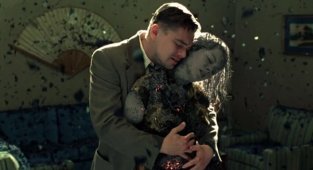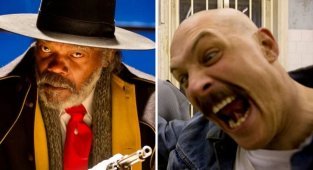Brain explosion: 9 puzzle films that not everyone can solve (10 photos)
Puzzle films are a phenomenon that intensified in the 1990s and 2000s. It is at this time that stories where the hero is involved in the game, where the status of his sanity flickers, where there is often distrust of the world on the screen or where there is a broken time line, become especially numerous. 
Shutter Island (2009) 
Released the same year as Nolan's Inception, Scorsese's film (again starring Leonardo DiCaprio) has spawned quite a few fan theories. The film began with the arrival of two partners Tedd and Chuck on a remote island where a mental hospital for criminals is located. The police's task was to find the dangerous fugitive Rachel Solando, but it soon became clear that Tedd had a personal motive for being on the island: his wife died in a fire, the culprit of which was located in one of the hospital buildings. In his film, Scorsese created a closed space where the hero is tormented by flashbacks about the Dachau concentration camp, dreams of his wife who is crumbling into black ash in his arms, where the rain pours like a wall and bright light bursts into the frame every now and then. In this strange detective story with disguises and ghosts, where mutilation, sleep and trauma are considered synonymous, the truth turns out to be too heavy a burden for post-war man.
Case (1987) 
The film by the Polish classic, filmed in 1981, is an example of the fact that films called puzzles existed even before the 90s. The film has three parts, and each begins with the main character Vitek running after a departing train to Warsaw. The first time he succeeds and becomes a communist, who is not without sympathy for the opposition, but does not dare to leave the party. In the second, he fails to catch a train and joins the anti-communist movement. The third time he is late again and meets a girl with whom he starts a family, refusing to take any political position. The unexpected ending of the film allows you to take a fresh look at everything that has happened in it up to this point. The film was banned by the Polish authorities for six years, and then released in censored form (one of the scenes is still considered lost).
Hour of Reckoning (2003) 
Hong Kong director John Woo based the work of Philip K. Dick in the early 2000s, an action film about an engineer who creates a device that can look into the future. The three years that Michael Jennings was involved in development were erased from his memory, and instead of the promised fee, he received some rubbish in an envelope: a lighter, unfashionable glasses, a pack of cigarettes, a coin, a piece of fortune cookie paper, etc. However, he soon finds out that he sent all this to himself and each of the items will be useful to him at a very specific moment in the future. We won’t reveal what conclusion the objects from the envelope will lead to Ben Affleck’s character, but John Woo’s cool direction is in no way inferior to the actual plot twists. He uses split screen, short editing, and Uma Thurman's blue eyes with ease and ingenuity. The film cannot do without the director’s favorite image - the saving white dove, which at the decisive moment flies into the frame in slow motion. Those who were impressed by the way they shoot down a helicopter with a pistol in 007: SPECTER should see Affleck's character stopping an electric subway train with a paper clip.
Illusion of Flight (2005) 
A passenger plane departs from Berlin to New York. On board, Kyle Pratt approaches the conductors and asks for help finding her child, a six-year-old girl. When a joint search leads nowhere, the mother throws a scandal. However, the woman has neither her daughter’s belongings nor the ticket, and there is no information about the girl in the passenger database. Robert Schwentke's film is a good example of a whole subcategory of puzzle films where no one believes the heroine. She is convinced that she is being deceived (usually about the child), but after overcoming a moment of weakness, she still finds a way to uncover the conspiracy. Just the creepiest scene in “Illusion of Flight” is the scene with the psychotherapist, where the woman begins to doubt what is happening. But, fortunately, the heroine of Jodie Foster quickly comes to her senses: her composure, professional knowledge of the aircraft and the ability to break the nose of a bad guy make her more like the heroine of an action movie rather than a thriller.
Jacob's Ladder (1990) 
Jacob Singer returns to New York after being wounded in Vietnam. Suffering from severe PTSD, he constantly thinks about the atrocities that happened at the front. These thoughts are mixed with memories of his son and terrible hallucinations, and Jacob gradually loses touch with reality. The film is included in a separate subcategory, where, as a rule, according to the plot, the main character does not understand whether he is alive or dead. Bruce Rubin's script, filled with Old Testament allusions and references to the Tibetan Book of the Dead, had been floating around Hollywood for several years. At various times it was offered to Ridley Scott and Sidney Lumet, but finally it ended up in the hands of Adrian Lyne, already known primarily for the film Fatal Attraction. In the year of its release, the film was not very successful at the box office, but it gained absolutely cult status, influencing the Silent Hill series of games, the films “The Sixth Sense” by M. Night Shyamalan and “The Jacket” by John Maybury.
Run Lola Run (1998) 
Lola runs three times through the streets of Berlin. In each of the three versions of events, she has only 20 minutes to find a round sum of money for her beloved Manni, who is in trouble. Seconds flash by in her acid-red hair, any action she makes, any choice along the frantic route will affect the result. German director Tom Tykwer rejected motivations and caught the pace of the era. In 1998, the film collected a lot of awards, including the main audience award at the Sundance Film Festival. The film is often compared to Kieślowski’s aforementioned “The Chance,” emphasizing that both films explore the role of chance and will in human destiny. In “Run, Lola, Run,” this motif is aggravated in a scene in a casino, where the heroine breaks glasses with a loud cry and makes the roulette ball land on the number she wants.
Spider (2002) 
A rumpled, damaged-looking man in four shirts, a jacket and a raincoat named Dennis Cleg disembarks from a train at London Station. He spent 20 years in a madhouse and is now going to a special boarding house. Cleg begins to remember the dark events of his childhood, in which the trauma that sent his whole life downhill is rooted. Gradually, the past and present are intertwined in the web of reflection of the protagonist about how his fate turned out. Chief film scientist David Cronenberg, with the help of precisely drawn threads of montage phrases, outlined the consistent transformation of a child into that same humiliated Spider. The final twist, as always on our list, makes you look at what is happening from a different angle. Ralph Fiennes plays the lead role in this perfectly put together, slowly creepy film. The film was shown at the Cannes Film Festival in 2002 and received rave reviews from critics.
Detonator (2004) 
Debutant Shane Carruth shot “The Detonator” in 2004 on 16 mm for only seven thousand dollars at home in Dallas and received the main jury prize at the American Sundance Film Festival. Add to these circumstances the mass of comments, articles, forum posts written about this film with hatred or admiration over all this time, and we get probably the most iconic puzzle film. In the story, two friends in a garage are developing something like a time machine that can give them everything they want. However, they face the consequences of their experiments. The history of the inventors is so convoluted and so merciless to the viewer in terms of the use of scientific theories that a trip to YouTube for an explanatory brigade is almost inevitable.
Donnie Darko (2001) 
Another cult debut from Sundance, as its director himself later explained, is built on the idea of a space-time loop. However, to find scientific words for what is happening on screen in this schizoid teen film is to miss the pleasure of its strange, dreamy imagery. The plot centers on Donnie Darko (Jake Gyllenhaal), a high school student who is approached by someone dressed as a soft but frighteningly toothy rabbit and predicts the end of the world. After that, Donnie will cause floods, burn down houses and watch "The Evil Dead" at the local cinema, and in the end he will be at the right time and in the right place so that the cover of "Mad World" plays shrilly and accurately over the credits.


